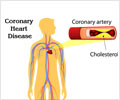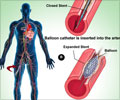Seven in ten patients who have suspected angina are not given appropriate testing and are more likely to suffer from serious heart problems as a result, according to a study published on bmj.com today.
Women, older people, patients from ethnic minorities and the poor are the most likely to miss out on testing.The researchers, led by Professor Gene Feder from the University of Bristol, decided to look into whether patients had equal access to coronary angiography (a specialist x-ray examination in which a contrast agent is injected into the arteries around the heart to show the extent and severity of the narrowing of the arteries around the heart). They wanted to find out if not having an angiography in the early stages of heart disease, when a person presents with suspected stable angina (pains in the chest after exertion), has a long term impact on patients’ health.
The researchers studied 10,634 patients with suspected stable angina attending six chest pain clinics in England, between January 1996 and December 2002. The sample included white and south Asian patients with chest pain and no known coronary heart disease.
An independent panel of doctors found that 1,375 of these patients needed an angiography. Each patient was followed up three years later to find how and if heart disease had progressed, for example whether they had developed unstable angina, or suffered a heart attack or other heart related problems.
They found that overall 69% of patients deemed appropriate for angiography had not had one. In addition, people over 65, women, south Asian patients, and those in the most deprived fifth of the population were less likely to receive the test compared with those aged under fifty, men, white patients, and those living in the less deprived areas, respectively.
Importantly, deaths from heart disease and admissions for heart attacks and unstable angina were more common in the group who had not had an angiography.
Advertisement
They conclude that further research is needed to support doctors in improving their decisions about further investigation of patients with new angina.
Advertisement
SRM/L









